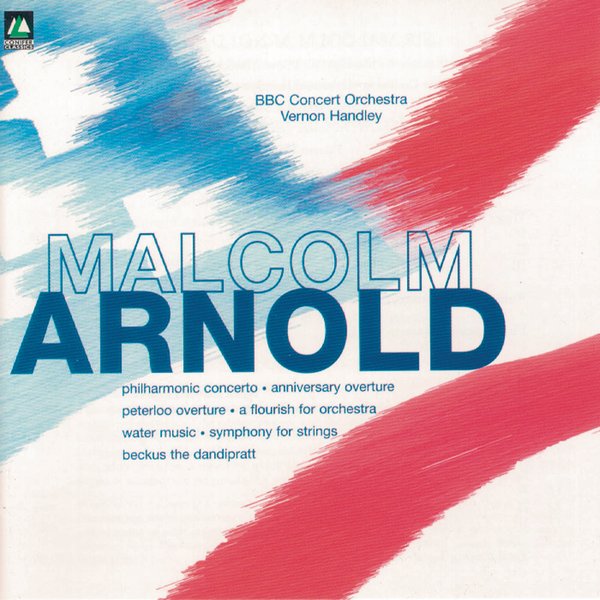Arnold: Symphony 1 & 2
Malcolm Arnold's first two symphonies are decent creations. Many find his second to be amongst his finest efforts.
I believe the composer's best attribute as a symphonist is his highly memorable melodic ideas. They may be short and fragmentary, but Arnold uses them again and again in differing ways, never letting the listener lose ground thematically.
This is an important aspect since Malcolm Arnold often moves down curious and unexpected paths. Sometimes he is in filmic mode, others in modernistic tones, and still he can launch into populous forms and ideas which seem unrelated, or at least contrasting, to everything which came before.
All of these elements are a prelude to what can easily be found in Malcolm Arnold's Symphony no. 1. I love the composer's specific use of piccolo and harp, a quirky sound across these works. When Arnold bursts into a high-stepping march in the final movement, almost one of a sarcastic vein, he uses it as a transition to a rather grand, slightly discordant yet filmic conclusion, one of Arnold's great contrasts.
The First Symphony's opening movement displays Arnold's highly rhythmic intricacies, while layering the instrumental sections in what sounds like bi-tonal harmonies. Of course, his love of glissandos comes across well, creating both avant-garde and lush textures in those sections. The middle movement is rather atmospheric, allowing Arnold to explore unusual orchestral colors and instrument combinations. To me, at times he sounds like John Williams in scene setting mode.
Vernon Handley's performance with the Royal Philharmonic Orchestra is one of the fastest on record coming in at 27 minutes. At 39 minutes, the composer's own recording is well known for being a notoriously slow account. The middle ground is represented by Richard Hickox on Chandos, who may be the best in this field, although I prefer Handley's lither-sounding orchestra over the monumental sound from the LSO.
Many of the observations from Symphony no. 1 easily apply to Malcolm Arnold's Symphony no. 2.
Differences include a four-movement structure and a more confident musical approach overall. It is easy to see why listeners may prefer this symphony over its earlier sister composition.
The solo clarinet at the start is nearly folk-like, a beautiful tune to base a movement on, no matter which instruments are afforded its pleasures. Arnold provides a plush background to this rather lyrical opening movement. A militant idea tries to elbow itself into the music, but generally, this music lays in a relaxed manner.
As the Second Symphony wends on to the middle Scherzo and Lento movements, I am taken with Arnold's use of extensive percussion, raucous high horn, and the presence of a contrabassoon, although some appearances of clarinet and trumpet reminds me of Americana more than Britannia. The nearly 13-minute slow movement displays even more of the composer's atmospheric melancholy, this time sweaty and dense in feel. Bandying lush harmonies with light dissonance and bi-tonality, cushions a host of wind / brass solos and ensemble features, most memorably the Sergio Leone piccolo moments for this listener.
When I arrive at the last movement, I am reminded of the English folksong suites of Holst or Vaughan Williams, although Arnold's sequencing is a little too casual. An exciting brass interlude with orchestra hits leads to a quirky string smear section with odd dance rhythms and wind virtuosity. A very fun ending to a worthwhile symphony.
In Symphony no. 2, timings are very close between recordings. Choices will depend on sound and approach. While I highly enjoy Vernon Handley's brightly-played performance here, I will admit to John Barbirolli's standard-bearing presence in Malcolm Arnold's symphonies.
Since Decca's set includes Arnold's Symphony for Strings with his first two symphonies, I will cover it briefly here.
I generally find this work discursive and wiry, much in the same way I found the composer's early String Quartet no. 1 somewhat acidic in its use of dissonance.
Oddly, the first movement adds sequences of lounge-act rhumba rhythms, taking my mind off of the angular astringency for a few moments. Again, string glissandos appear throughout the work, cementing this music with a modern stance.
The middle movement is a humorless affair, where Handley takes the moderate tempo impulsively, thankfully without any sense of dragging. While the last movement might be slightly lighter, it doesn't last for long, making for a rather surly work overall.
Here, the BBC Concert Orchestra is captured very closely, where the strings sound thick and weighty, never losing any of Arnold's extra string techniques or attacks. It doesn't look like the Symphony for Strings has been as eagerly recorded by others, although I see it on a Naxos release I haven't heard. Knowing that label and their use of a chamber orchestra, I would expect a contrasting string sound to Handley's there.
Works
Symphony for Strings, op. 13 (20.23)
Symphony 1, op. 22 (27.15)
Symphony 2, op. 40 (29.36)
Performers
BBC Concert Orchestra (op. 13)
Royal Philharmonic Orchestra
Vernon Handley, conductor
Label: Conifer
Year: 1994, 1996, 1997; 2006
Total Timing: 77.14
Find more Arnold recordings HERE!



Comments
Post a Comment